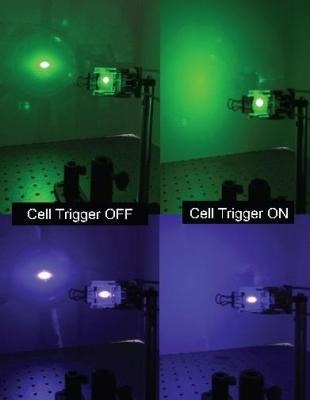Apr 1 2019
It is a dangerous prank to aim a laser beam at an aircraft. The unexpected flash of bright light can incapacitate the pilot, endangering the lives of all aboard. But since attacks can take place with different colored lasers, such as green, red, or even blue, scientists have had a tough time developing a single technique to hinder all wavelengths of laser light. Currently, scientists report liquid crystals that could in the future be added into aircraft windshields to obstruct any color of bright, focused light.
 Liquid crystals sandwiched between two1-inch squares of glass scatter green and blue light on a wall when the cells are triggered by laser illumination (right panels). (Image credit - Daniel Maurer)
Liquid crystals sandwiched between two1-inch squares of glass scatter green and blue light on a wall when the cells are triggered by laser illumination (right panels). (Image credit - Daniel Maurer)
The results from the study were recently presented at the American Chemical Society (ACS) Spring 2019 National Meeting & Exposition. ACS, the largest scientific society in the world, and the meeting features nearly 13,000 presentations on a wide range of science topics.
According to the Federal Aviation Administration, 6,754 laser strikes on aircraft were recounted in 2017. "We were approached by collaborators in the aviation department at our university about the growing problem happening at airports across the world, where people were shooting lasers at planes during takeoff and landing, the critical phases of flight," says Jason Keleher, Ph.D., the project's chief investigator. Such attacks, which cause bright flashes of light in the cockpit, can confuse pilots or cause permanent or temporary visual damage, subject to the intensity and wavelength of the laser.
"We wanted to come up with a solution that didn't require us to completely re-engineer an aircraft's windshield, but instead adds a layer to the glass that harnesses the existing power system for windshield defrosting," says Daniel Maurer, an undergraduate student. Keleher and Maurer are at Lewis University.
Instead of being combined into the windshield, earlier approaches have incorporated pull-down windscreens or goggles that pilots can wear during landing and takeoff. However, these can be problematic because they need the flight crew to take these safeguards whether or not they are truly being targeted. An even bigger issue is that these approaches work only for particular wavelengths of laser light. "They don't block everything," Maurer says. "They're usually targeted toward green lasers because those are used for the majority of the attacks."
To formulate their new method, the scientists exploited liquid crystals—materials with properties between those of liquids and solid crystals that make them advantageous in electronic displays. The researchers put a solution of liquid crystals known as N-(4-methoxybenzylidene)-4-butylaniline (MBBA) between two 1-inch-square panes of glass. MBBA has a transparent liquid phase and an opaque crystalline phase that disperses light. By conveying a voltage to the apparatus, the team caused the crystals to line up with the electrical field and experience a phase change to the more solid crystalline state.
The aligned crystals blocked up to 95% of red, green, and blue beams, through an arrangement of light scattering, absorption of the laser's energy, and cross-polarization. The liquid crystals could obstruct lasers of varying powers, mimicking various distances of illumination, as well as light shone at diverse angles onto the glass.
Furthermore, the system was totally automatic: A photoresistor detected laser light and then activated the power system to convey the voltage. When the beam was removed, the system switched off the power, and the liquid crystals returned to their transparent, liquid state.
We only want to block the spot where the laser is hitting the windshield and then have it quickly go back to normal after the laser is gone.
Jason Keleher, Ph.D., Study Chief Investigator, Lewis University.
The rest of the windshield, which was not hit by the laser, would stay transparent throughout.
Now that the scientists have demonstrated that their method works, they aim to expand it up from 1-inch squares to the size of a full aircraft windshield. Preliminary results have revealed that a sensor grid pattern on 2-inch squares of glass will react only to the section of glass that is lit. The team is also analyzing various types of liquid crystals to identify even more efficient and adaptable ones that return to the transparent state more rapidly after the laser is removed.